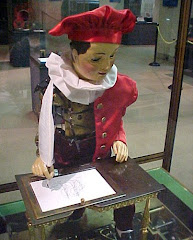by James Elkins
Within aesthetics, exchanges about the nature of forgery have been made largely in response to Nelson Goodman’s Languages of Art (1968). In his original scenario we are invited to contemplate two paintings: one is authentic and the other is forged, but we cannot distinguish them by “merely looking,” without the aid of X-Rays and chemical analyses. Our different aesthetic response to the two paintings is used to argue, in the words of Joseph Margolis, that “there are bound to be aesthetically relevant considerations in the appreciation of art that are not directly accessible to perception or to any other relevant mode of experience.”[1] Historians have been largely silent during the debates on Goodman’s claim: not, I think, because it is not an important problem, but rather because what matters to historians are the imperceptible considerations in any given case, rather than the simple existence of such considerations.
Paper.
Sunday, 5 October 2008
Subscribe to:
Post Comments (Atom)




No comments:
Post a Comment